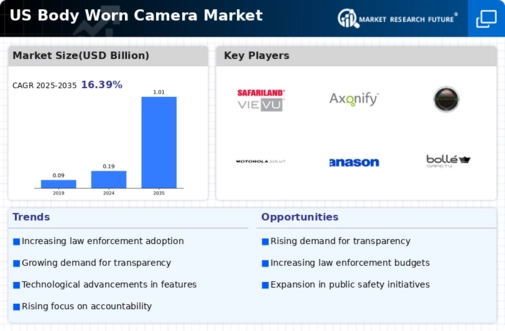Growing Focus on Public Safety
The body worn-camera market is significantly influenced by the growing focus on public safety across various sectors. With rising concerns about crime rates and public safety, law enforcement agencies are increasingly adopting body worn cameras as a proactive measure. This trend is evident in the allocation of federal and state funding aimed at enhancing public safety initiatives, which often includes the procurement of body worn cameras. In 2025, it is estimated that funding for body worn-camera programs has increased by 20% compared to previous years, indicating a strong commitment to improving safety measures. The emphasis on public safety is likely to drive further investments in the body worn-camera market, as agencies seek to leverage technology to protect both citizens and officers.
Legal and Compliance Pressures
Legal and compliance pressures are emerging as a significant driver in the body worn-camera market. As legal frameworks evolve, law enforcement agencies are increasingly required to adopt body worn cameras to comply with state and federal regulations. The implementation of policies mandating the use of body worn cameras in various jurisdictions is becoming more common, thereby propelling market growth. In 2025, it is estimated that over 30 states have enacted legislation requiring the use of body worn cameras by law enforcement, reflecting a shift towards standardized practices. This regulatory environment is likely to create a robust demand for body worn cameras, as agencies strive to meet compliance requirements while enhancing operational efficiency. The body worn-camera market is thus positioned to benefit from these legal mandates.
Increasing Demand for Accountability
The body worn-camera market is experiencing a notable surge in demand driven by the increasing need for accountability in law enforcement and public safety sectors. As incidents of misconduct and public scrutiny rise, agencies are adopting body worn cameras to enhance transparency and build trust with communities. According to recent data, approximately 70% of law enforcement agencies in the US have implemented body worn-camera programs, reflecting a commitment to accountability. This trend is likely to continue, as public expectations for transparency grow. Furthermore, the integration of body worn cameras into standard operating procedures is becoming a norm, thereby solidifying their role in the body worn-camera market. The potential for these devices to provide critical evidence in legal proceedings further underscores their importance in fostering accountability within law enforcement.
Technological Integration and Innovation
Technological advancements are playing a pivotal role in shaping the body worn-camera market. The integration of advanced features such as live streaming, GPS tracking, and cloud storage solutions is enhancing the functionality of these devices. Innovations in battery life and video resolution are also contributing to the appeal of body worn cameras. For instance, the introduction of 4K video recording capabilities is becoming increasingly common, allowing for clearer and more detailed footage. As of November 2025, the market is projected to grow at a CAGR of 15% over the next five years, driven by these technological innovations. The continuous evolution of software and hardware in the body worn-camera market is likely to attract more users, including private security firms and corporate entities, thereby expanding the market's reach.
Enhanced Training and Operational Efficiency
The body worn-camera market is also being driven by the need for enhanced training and operational efficiency within law enforcement agencies. Body worn cameras provide valuable insights into real-life scenarios, enabling agencies to improve training programs and operational protocols. By reviewing footage, agencies can identify areas for improvement and develop more effective training methodologies. This application of body worn cameras is becoming increasingly recognized as a vital tool for professional development. As of November 2025, it is estimated that agencies utilizing body worn cameras for training purposes have reported a 25% improvement in officer performance metrics. This trend suggests that the body worn-camera market is not only about accountability but also about fostering a culture of continuous improvement and operational excellence.





















Leave a Comment